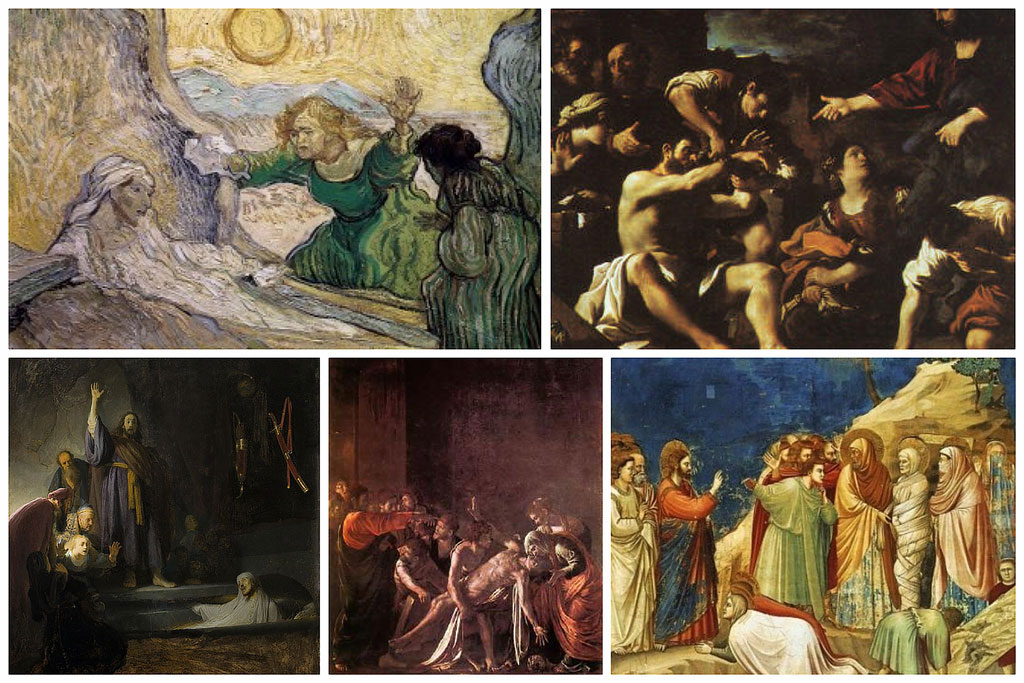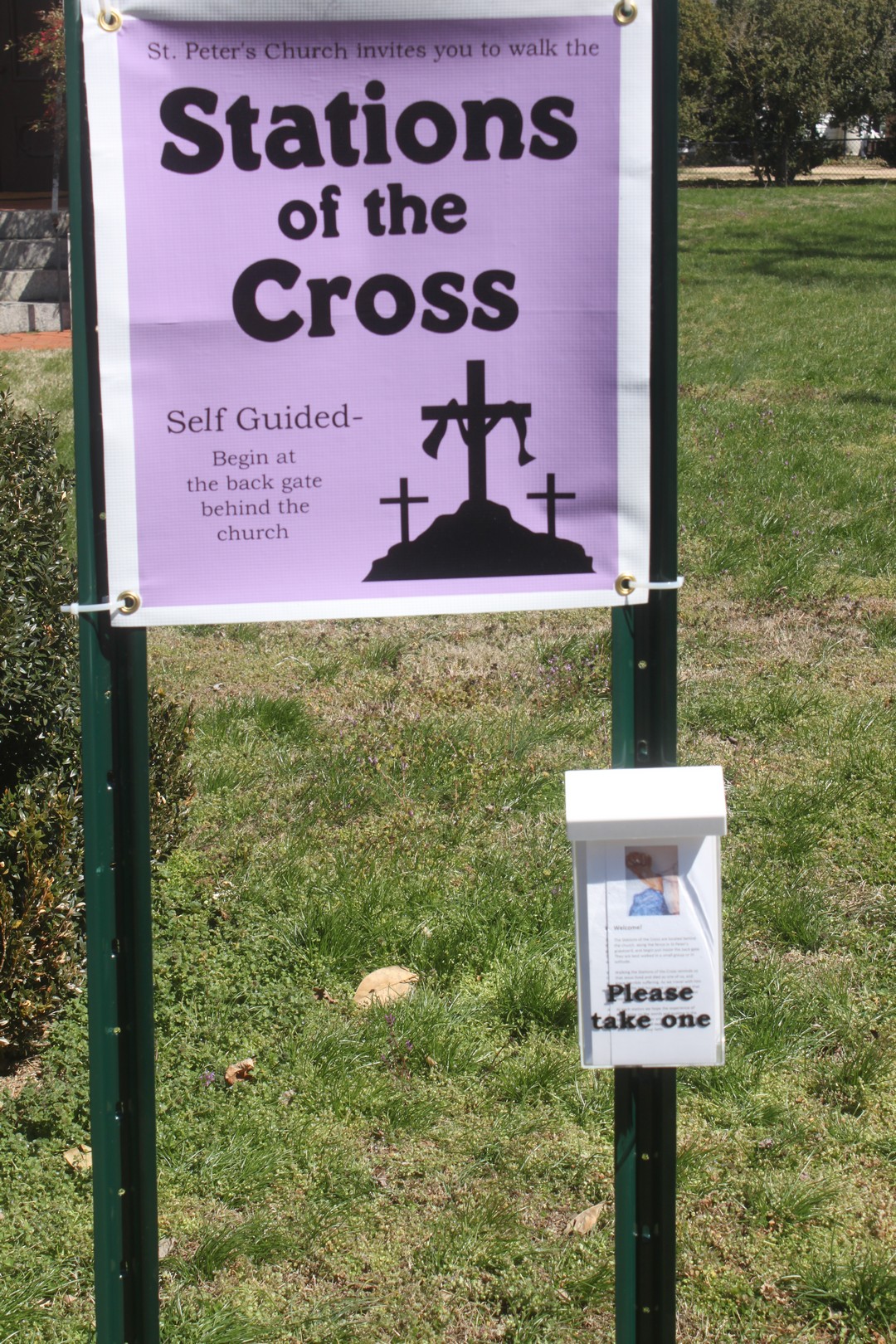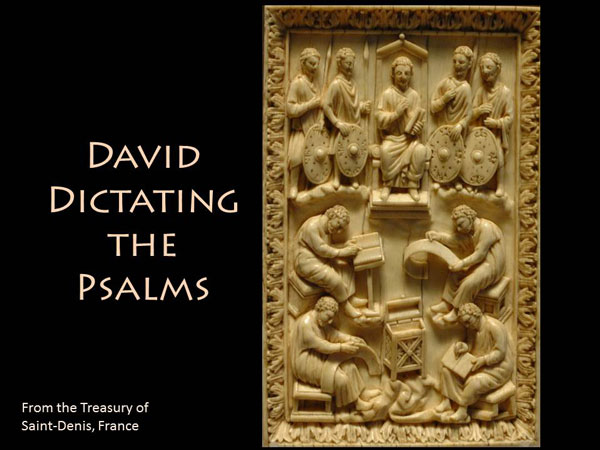I.Theme – Death and Resurrection

![]()
"Raising of Lazarus" – Giotto (1304-1306)
The lectionary readings are here or individually:
Old Testament – Ezekiel 37:1-14
Psalm – Psalm 130 Page 784, BCP
Epistle –Romans 8:6-11
Gospel – John 11:1-45
Death and resurrection are the themes that permeate the lessons today. The image is that of forgiveness and redemption certified by resurrection and new life. The Psalmist awaits Yahweh’s redemption both for himself and for Israel. Ezekiel witnesses and even participates in the reanimation of dead Israel in preparation for her return to her land. The promise to new life for those filled with the Spirit of the Lord is the resurrection of Jesus. And Lazarus points ahead from his resurrection to the greater, more complete and dynamic resurrection of Jesus.
Contrast is used in this readings. Ezekiel’s story is that of the "dry bones" where we see lifeless, nake bones being reconstituted. Paul contrasts the life of the flesh, which draws from sin and leads to death, with the life of the Spirit, which draws from the Spirit of Christ and leads to righteousness. In today’s gospel, we hear the story of the death and raising of Lazarus, a foretaste of Jesus’ own death and resurrection and of what all of us buried and raised with Christ in the sacrament of baptism both acknowledge (their own spiritual “stinking deadness”) and freely receive (the gift of new and eternal life).
II. Summary
Old Testament -Ezekiel 37:1-14
It is likely that Ezekiel was among those deported when the Babylonians first took Jerusalem, in 598 BC. He opposed a political solution to Judah’s woes, espousing instead the notion of Israel as a community faithful to God in religious observance and obedience.
Ezekiel prophesies in Babylon from 593 to 571 BCE among Judean exiles who have witnessed wholesale death, destruction of culture and stresss of dislocation. The selection is a word of comfort and assurance
Ezekiel is desperate to shake his people out of their spiritual complacency.
1 Jerusalem is destined to be destroyed for its sin, and nothing can be done to save it. There can be no talk of salvation until after the judgment has occurred
2 After Israel has been punished, God will be faithful to the promises made to David and will restore Jerusalem’s status as the eternal divine dwelling place. . God is a God of justice, faithfulness and redemption and will not abandon his people.
The reading here is a prophecy or vision. The scene are dry bones are in a valley an arid place, perhaps the site of a battle. It is not clear why they weren’t buried. The bones are “very dry”, long lifeless; they symbolize the exiles, who lack hope of resuscitation of the kingdom of Israel. For Israel this vision spoke of moral and spiritual bankruptcy. . Ezekiel was a man of vivid imagination and symbolism; a man of deep spirituality and holiness, preaching the need for personal spiritual renewal and penitence and that of the nation.
Contrasting with the dead bones are “breath” and “spirit.” The prophet declares the divine message in which Yahweh declares his intention to cover the bones with flesh and skin and fill them with breath. God will renew the covenant, restoring Israel – but probably spiritually rather than literally. It is the Spirit of God of course which brings about this resurrection.
Psalm -Psalm 130
This is a prayer for deliverance from personal trouble, but it ends with a message to all people. The “depths” are the chaotic waters, separation from God – as in Jonah’s prayer from the stomach of the great fish. This is an unusual psalm of despair and anguish as well as hope
Psalm not only helps vocalise that despair but gives blessed assurance and reassurance that God’s constant love not only forgives all wrongs but will carry us through everything.
“From the depths of my despair, I call to you,” says the Psalmist in verse one, speaking of the Hebrew belief in Sheol the land of the dead, into which the dead were believed to sink never to reappear. He is in hell at that moment. And longs for God to carry him through as God allowed the people to pass through the waters of the Red Sea.
May God be attentive to my pleas. God forgives, so he shall be “revered” (v. 4). If God were to record all our misdeeds, how could anyone face him? He is merciful by nature, so I eagerly await his help, his “word” (v. 5), a prophecy from him. I wait as do watchmen guarding a town from enemy attack (v. 6). Perhaps (v. 7) the psalmist has now received a prophecy of salvation which he tells to all Israel: wait in hope for God; he offers unfailing “love”, freedom from grievous sin.
Epistle -Romans 8:6-11
Paul has written that, as a result of God’s love shown in the liberating act of Christ’s death and resurrection, we are empowered to live a new life, one of freedom from sin, from the finality of death and the Law. As experience shows, the Christian is able to live a life for God, in the Spirit. Christian life is bound up in the Spirit, and not by the desires of the flesh.
Life and death; physical and spiritual; the way of the flesh or the way of the Spirit are the themes of these few verses,.two very different mindsets (v. 6). A person whose mind “is set on the flesh” (v. 7), whose view is limited to the natural world, is at enmity with God because he is fundamentally unable to obey God’s law – he lacks the power to transcend his inner conflicts, and “cannot please God” (v. 8).
The Spirit filled life is full of creativity, energy and intimacy with our God now and always. It is a life lived with the immense power of God – the power that raised Jesus from the dead. To Paul the choice is frustratingly easy – Choose life and live by and with the Spirit
Christians are in the Spirit (v. 9) and the “Spirit … dwells in you”, i.e. the Spirit fills and motivates our lifestyle. Attachment to Christ (belief in him) is only possible in this kind of relationship: Christ and the Spirit come together.
Vv. 10-11 say: if Christ (or the Spirit) is in you, though you may be a corpse because of all the wrong you have done, you are actually very much alive – because of the Spirit. If God’s Spirit is in you, God will resuscitate your bodies (from being corpses) through the Spirit, in raising you to new life at the end of time. We want to choose life but the way of the flesh often drowns out the voice of God
The Covenant Promise of Israel was to a life of security in the land promised from Moses time. Life in Christ is very different as it is personal as opposed to that of the Community or nation; life for Paul is life in all its fullness here and through all eternity; death means separation from God.
Throughout his letters we can see how important it was to Paul how we live here and now. We can either “live in Christ” and have “Christ live in us”, or unthinkably we live without Christ.
Gospel – John 11:1-45
The raising of Lazarus is the event which is the climax and conclusion of Jesus’ public ministry. It is also the 7th sign in John’s second part of his Gospel. It has been said that John starts with a wedding (Cana) and ends with a funeral (Lazarus). This particuarly story is only a part of John. John’s Gospel is all about the power of God which Jesus used in all his miracles and signs proving that Jesus is the Messiah, the Christ, The Son of God.
Who is Lazarus ? He is most likely the guardian of his sisters at the time of his death. His death would seem, thus, to bring with it the specter of economic difficulties for the women.
Why 4 days? At the time of Jesus it was believed that the life force of the body stayed in close proximity for 3 days. So the repeated statement (Verses 17 and 39) that Lazarus had been in the tomb for 4 days stresses that he is beyond all hope of life.
The purpose of the miracle is so that the people might believe that God has sent Jesus. Death in John is separation from Christ. Jesus can not keep people from dying; but that Jesus will raise up the dead and that (physical) death will never separate believers from God
Lazarus can do nothing for himself. All he can do is receive the power of God to give him new life. A similar illustration is given in the first lesson from Ezekiel 37. The call to faith is a call to die, so that God’s power might be manifested in giving us life.
After this event Jesus retreats to wait for the coming of the Passover, his hour, and the climax of his life (John 11:54). The irony is that by saving Lazarus’ life it will lead to Jesus. The presence of many Jews (v. 19) will become witnesses to the miracle and then believe in Jesus (v. 45), which scare the chief priests and the Pharisees into the decision to kill Jesus in order to save the nation (vv. 48-52).
The actual raising of Lazarus occurs only at the end of the passage. Many authors suggests entire passage is centered on the theme of faith rather than resurrection or life. There are only 6 verses about the event but 20 about Lazarus sisters, Mary and Martha
Lazarus can be seen as a symbol of baptism. He submitted to the death and the days in the tomb, and then was raised to a new life by Jesus. Baptism is a symbolic death to our old life and a re–birth into a new life in Christ, which is precisely what happens with Lazars
Theologically, we died in baptism and we die in daily repentance, and God raises us to new life. However, sometimes after God has given us new life, we still want to keep ourselves wrapped up and bound in our grave clothes — signs of the old life. We can keep ourselves bound up by holding onto those sins from which Jesus has freed us and has forgiven us
Situation -Jesus is beyond the reach of the Jewish religious authorities, across the Jordan when Martha and Mary (in “Bethany”, near Jerusalem) send a message to him (v. 3): Lazarus, a follower, is ill. Jesus says that his illness is not terminal, rather it will show the “glory” (v. 4, power and authority) the Father has bestowed on the Son. Jesus delays two days
As with a number of John stories, there is a amount of confusion leading to Jesus to clarify the situation.
Disciples don’t understand about Lazarus condition They misunderstand Jesus’ words about "sleeping". When Jesus says that Lazarus is "asleep," they don’t get that he means he is dead. When Jesus suggests a journey to "wake him up," the disciples question his judgment. After all, if Lazarus is sleeping, they figured that that’s a good sign that the worst of his illness has past, and, besides, doesn’t Jesus realize the danger that awaits him in Judea? They are reluctant to go with Jesus, because they might die. Jesus replies with a parable: there is still time (“hours of daylight”, v. 9) to do God’s work; harm will not come to him “during the day
The disciples are not great models of faith. Restoring Lazarus to life will be a greater opportunity (than just healing him) for strengthening the disciples’ faith in Jesus (v. 15).
The second part of confusion are the sisters of Lazarus. . Perhaps Martha sets out to warn Jesus of the rites while Mary receives mourners Both his sisters are somewhat miffed Jesus didn’t get there earlier. The exploration of faith is really with Lazarus two sisters, Mary and Martha. For the time, it is exceptional that Jesus is evening having a conversation with a woman
Mary and Martha both start out the same way. Why didn’t you get here earlier but it becomes more affirming and understanding. Martha said to him, "I know that he will rise again in the resurrection on the last day" though she did not expect sooner. When Martha is pressed by Jesus to go beyond the understandings current in the Judaism of the day (expressed in 11:24), she makes a confession of Jesus as the Christ, the Son of God (a messianic term), and as the one coming into the world. “Lord, I believe that you are the Messiah, the Son of God, the one coming into the world."”
Jesus identifies himself as he who raises believers from death (“resurrection”, v. 25) and who is the principle of “life”. Physical death is normal, even so life in Christ will continue, and this life cannot be taken away by the death of the body
She comes to a full understanding of Jesus though she may not know Lazarus will be raised earlier than the last day. This is an endorsement of both the need for faith and the need to strive for a fuller understanding of the meaning of the faith. Yet even at the moment of the opening of the tomb her faith is not enough to believe that her brother, really will “come forth”. (verse38)
She discerns that Jesus wishes to speak to Mary. She tells Mary “privately” (v. 28) either so she can escape from the visitors or to shield Jesus from any who plot against him. The visitors see Mary leave, and follow her
Mary is more emotional and expresses concern about Jesus delay but that’s about as far as she gets. She doesn’t utter all the proper phrases like Martha about the all-powerful Jesus, the Messiah, the Son of God or any belief about the resurrection of the dead. Mary just cries.
A very important theme in this gospel surfaces in this lesson. This is the idea of Jesus’ glorification, which is first mentioned here in 11:4. The reference here is to a future event, which we are well aware is the event of the crucifixion.
III. Articles for this week in WorkingPreacher:
Old Testament – Ezekiel 37:1-14
Psalm – Psalm 130
Epistle – Romans 8:6-11
Gospel – John 11:1-45






